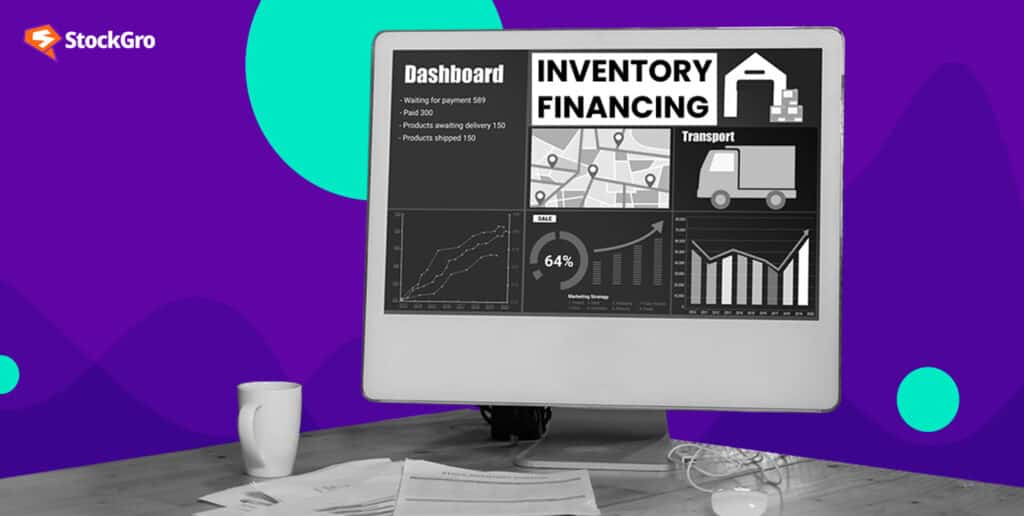
Introduction
Businesses often require finances to either scale their operations or as a means of investment. A common way to get these finances is securing a loan called inventory financing. This loan option comes in handy when trying to monetise the inventory to use the funds in other directions. The inventory serves as the collateral for businesses to seek a loan amount.
Let us look at what is inventory financing in-depth, along with its working, types, advantages, and disadvantages.
What is inventory financing?
Inventor financing refers to a loan or line of credit that is built against the inventory value. The inventory serves as the collateral to get the loan amount. This technique is particularly useful for businesses that pay the warehouses in advance for stocking their inventory before it is finally sold to the customers.
The process of inventory financing assists in better managing seasonal fluctuations and smoothing out finances in such cases. Additionally, it is also beneficial for businesses that do not have a strong business history as a record for seeking business loans.
How does inventory financing work?
Inventory financing is a form of asset financing that helps businesses gather funds for purchasing materials used in manufacturing products to be sold at a later date. Lenders estimate the sale value of the inventory and extend a loan amount accordingly.
Just like a loan repayment schedule, they set up repayment terms and duration. In case of failure of repayment, the lender has the power to sell the inventory and retrieve the money. In most cases, lenders offer close to 90% value of the inventory but the figure can vary based on industry specificities and records.
The key reasons behind opting for inventory financing loans are maintaining a steady cash flow through the fluctuations in busy and slow seasons, increasing the inventory supply, catering to high customer demand, and introducing new product lines. These reasons cover all the possibilities of why a business can potentially require more funding for its production purchases.
This kind of finance is most commonly utilized by mid-sized wholesalers and retailers who have a large available stock. These businesses usually lack the financial history and assets to avail of conventional business loans.
Types of inventory financing
Let us now look at the two types of inventory financing possibilities that businesses can choose from based on their requirements. These include:
Inventory loan
Also known as term loans, inventory loans are calculated based on the total value of the company’s inventory. It works with the same arrangement as a regular business loan where the lender provides a certain amount as a loan and repayment is scheduled with monthly instalments.
Line of credit
The line of credit is a kind of inventory financing that provides businesses with a revolving line of credit. This gives access to a regular amount of credit till the time the commitment of making monthly repayments is honoured.
Also Read: How to build financial resilience in times of economic uncertainty?
Advantages of inventory financing
The advantages of inventory financing are plenty, which makes it a common source of availing loans for several small and mid-scale businesses. These include:
- No requirement for a credit history
By opting for inventory financing, businesses no longer have to show an extensive credit history to win the trust of the lender. Since the inventory offered acts as an asset, the need for a credit history is eliminated.
- Eliminates the need to offer personal assets
During periods of high demand, businesses might have to pool in their assets or resources to finance the materials. However, with inventory financing, there is no such need and external funds can be sourced easily. It keeps the personal finances and assets safe.
- No strong business record is needed
Businesses do not need to be established to be eligible for inventory financing. It helps relatively new businesses avail of loans and access credit quickly. This is among the most far-reaching benefits of inventory financing.
Disadvantages of inventory financing
With the advantages of inventory financing, it is crucial to consider its disadvantages as well before availing of credit. These include:
- Adds to the liabilities
An inventory financing might add to the liabilities of a relatively new business. The new companies may not have enough resources to pay which might hamper their credit history for the future and accumulate debt in the present.
- Restrictions on future credits
If the business loan is not handled effectively then it may cause restrictions in the future credit and limit the opportunities. Further, sometimes the lenders might not pay the full value of the inventory which might cause a shortfall or delays.
- High borrowing cost
Sometimes the cost of borrowing funds via inventory financing can be more than conventional borrowing sources. This adds to the interest rate and might burden a newly established business and even cut down profits.
Also Read: How to achieve financial freedom and live your best life?
Conclusion
It is crucial to understand what is inventory financing along with the inventory financing advantages and disadvantages. This borrowing source can work in the favour of several businesses that desire to scale their operations and get access to credit at an early stage.
Assess your business requirements to understand which type of inventory financing will be most suitable for you and consult different lenders to take a credit deal that is in your best interest. To learn more, stay tuned to StockGro!

